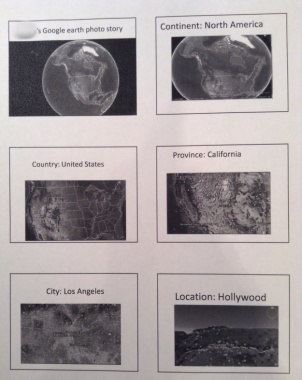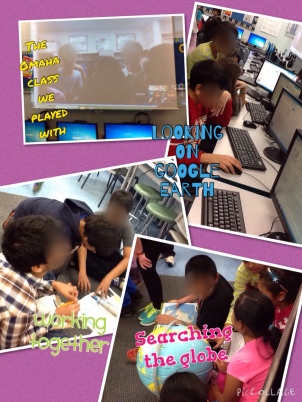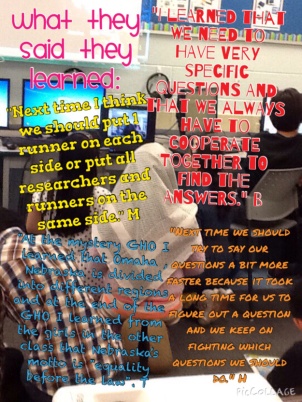Our Mystery Hangout
I’ve wanted to try a mystery video conference ever since I first heard about it on Twitter. As you may know, it involves two classes from different places asking yes/no questions about each other’s location and trying to figure out where the other is from. This game offers so many opportunities for learning that I just had to try it with my students.
So I researched it further and started laying the preliminary groundwork for myself and my grade six students. First, I got on Twitter to find a teacher that would be willing to try this with us. Once I found a willing participant, Kari Schroder, we agreed to take some time to prepare our grade 6 classes.
In order for my students to start thinking about specific locations in a way that would force them to zoom in from the largest land mass they are on (continent) through to the next (country, region, city), I introduced an activity I call ‘Google Earth Photo Story’. Students had to choose a location, then use Google Earth and Power Point to create a slide show that showed what continent, country, region, and city the location was in. The final product looked like this:
Next, we did a couple of mock ‘mystery’ conferences where students first had to question me then each other about a chosen location. At first they were getting stuck pretty quickly, so we started to developed strategies to overcome that. We started to think more critically about the questions we were asking and how we were wording them. We looked at a map of the world and talked about what other features (other than political division lines) we could use to help us zoom in on a location, such as lines of longitude and latitude or using the first letter of the name of the country (“Does it start with A-M?”). We had to talk through what getting a yes or no answer meant for many of the questions, about what we could eliminate. For example, if the country’s name did not start with the letter A-M, they could deduce that it had to start with N-Z. So their next question could be “Does it start with N-S?”, and so on. Students soon started developing their own strategies and ways of keeping track of the answers.
The day finally came when we were supposed to have our first Mystery Hangout. I assigned roles to each of the students based on the strengths I observed they had during our mock sessions. We had a greeter, questioner, answerer, two runners/communicators, photographer, two recorders, and the remaining students chose to be either Google researchers or part of the think tank that sat on the carpet and looked at the wall map, globe, and atlases we had available. Because of timetables and different time zones, the two classes only had 20 minutes in common. Soon after we made contact we discovered that the other class could not hear us. We tried to troubleshoot and get the technology to work but we just could not get them to hear us. Disappointed, we had to wave goodbye.
Two weeks had passed before I saw this class again. Since that morning, students from this class have been coming up to me and asking if we were going to try another Mystery Hangout. Thankfully, although I secretly questioned whether the students would still be excited after the flop two weeks earlier, I did arrange for another one (through Twitter, with Jessica Weber). This time we would have more time (about 40 minutes), and I made sure the microphone was working properly. The kids wanted to do another quick mock hangout, but I soon discovered that they did not need one. They remembered their roles and worked well together to communicate information and come up with questions. We only got to Province/State in out mock hangout before we heard back from the other class that they were ready. It was show time, and we were super excited (and me – nervous). I spoke to the other teacher for maybe 5 seconds before we turned it over to the students, thankfully all the tech cooperated this time.
Then I stood back and watched the magic happen. It was incredible, they were so engaged and eager. Everyone knew their role and did their best, and supported one another. Even though we had a few students get overly excited at times, calling out their question/answer or frustrated when they felt like they were not being listened to, they were quickly able to follow my non-verbal cues to pass on their messages to their respective ‘runners’ as we practiced during our mock sessions. I was so proud watching the students work together researching the location on the computers, helping each other along. They pointed out facts if someone made a suggestion that contradicted them. They re-grouped and backtracked if they got a ‘no’ answer to their question. Most importantly, they worked together with very little interference from me.
So What Did I Learn That Day?
- Student enthusiasm does not fade easily if given a chance to do something they are really interested in.
- Adopting a “Growth Mindset” is just as important for teachers as it is for students. Had I given up after the first failed attempt at a Mystery Hangout and not scheduled another, the students would have been very disappointed and we would have missed out on a great learning opportunity.
- Giving up control and trusting the students to take charge can lead to magic.
Here are some student reflections of what they learned:
This post was originally published on the Peel21st Project 188.
Posted on March 18, 2016, in 21st Century, Critical Thinking, Ed Tech, Teaching and tagged deductive reasoning, geography, mystery hangout, questioning. Bookmark the permalink. Leave a comment.




Leave a comment
Comments 0